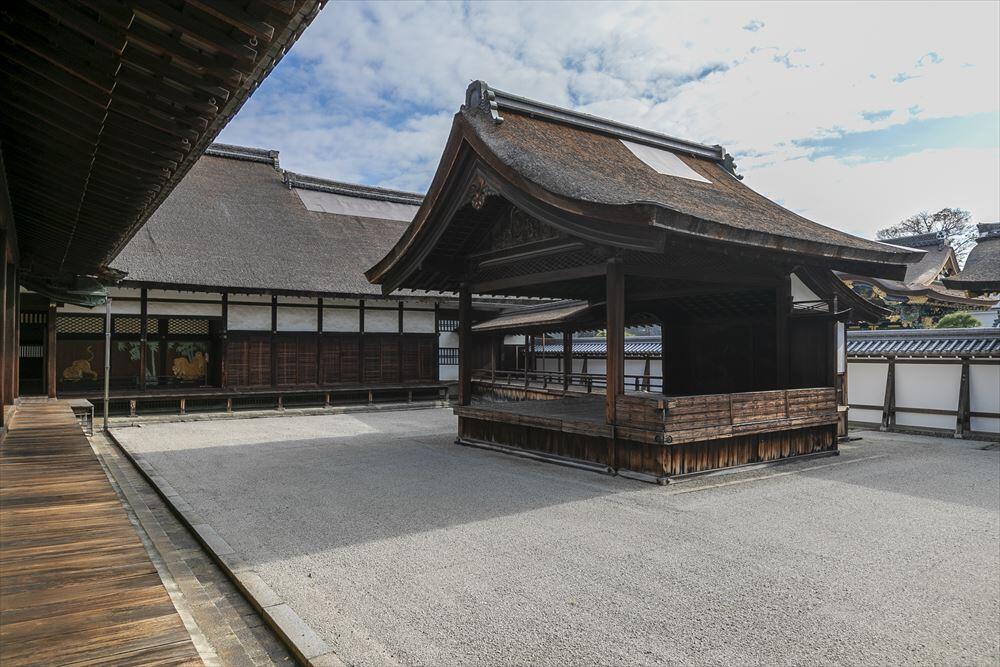音声ガイド_10_南能舞台
10.南能舞台(South Noh Stage)

日本語
この能舞台は、書院の南側に位置するところから「南能舞台」と呼ばれています。 屋外にある能舞台で現存するものとしては日本最大級の能舞台です。舞台にほぼ直角に取り付けられている長い橋懸りが特徴です。役者が橋を渡って舞台に進み出る際に橋が長くて間が持たない、ということから「役者泣かせの橋懸り」とも言われています。 正面に松の絵が描かれていますが、隠し絵の手法がとられており、縁側からでは見えにくいのですが、対面所の中から見ますと、大変よく浮かび上がって見えます。このことからも、対面所の上段の間から見てもよく見えるようにと、このような大きな能舞台が設置されたという説もあります。 本願寺では、毎年5月21日、親鸞聖人のご誕生をお祝いする降誕会という法要の際に、観世流による祝賀能が演じられます。
中文
10 南能舞台 這座能劇舞台因位於書院的南側,所以稱之為"南能舞台"。 南能舞台是全日本最大的室外能劇舞台。設有通向舞台的長長的橋型通道是南能舞台的主要特徵。可是也正因為這座通道橋太長,使得表演者在觀眾面前不得不長時間的保持登台和謝幕的姿勢,因此人們都叫它"累哭演員橋"。 另外,舞台正面用"畫中隱畫"的手法描畫了松樹。從走廊看得話不容易認得出來,而從"對面所"裡往外看的話,卻一切清晰可見。據說為了能讓大家即使在對面所的"上段之間"也能觀看得到能劇才建造了這麼大的能劇舞台。 每年的5月21日,本願寺在慶祝親鸞聖人誕辰的"降誕會"時會邀請"觀世流"來表演能劇。
한국어
10 미나미 노부타이 이 노부타이는 서원의 남측에 위치한다 하여 '미나미 노부타이'라고 불리고 있습니다. 현존하는 옥외노부타이로는 일본 최대급입니다. 이 노부타이는 무대에 거의 직각으로 설치되어 있는 긴 다리가 특징입니다. 배우가 다리를 건너 무대로 나올 때 다리가 길어 쉴 틈이 없다 하여, 속칭 '배우를 울리는 다리'라고도 합니다. 정면에 소나무 그림이 그려져 있는데 숨은그림 기법이 쓰여져 툇마루에서는 보이지 않지만 대면소 안에서 보면 매우 뚜렷하게 드러나 보입니다. 대면소의 윗쪽 방에서도 잘 보이도록 이러한 대형 노부타이가 설치되었다는 설도 있습니다. 혼간지에서는 매년 5월 21일 신란 성인탄생을 축하하는 '고탄에'라는 법요 때 능악의 일파인 '간제류'가 선보이는 축하 노부타이가 열립니다.
English
10 South Noh Stage Located to the south side of the chambers complex, the Minami or south Noh Stage is among the largest outdoor Noh stages in Japan. The passage perpendicular to the main stage serves not only as a walkway leading onto the stage, but where parts of the story are also performed. It is known as the hashigakari, and due to its length, there is a saying that actors often dreaded having to cross it for it would be where the audience evaluated their acting skills. On the back wall of the stage, is a pine tree that is painted applying a technique referred to as hidden painting. Standing outside and looking at the back wall, the image is difficult to see due to the glare. However, as you enter the Main Audience Hall, the image becomes much clearer and with depth, as if the tree had come to life. Noh was traditionally used by Hongwanji for propagational purposes and made popular by Rennyo Shonin in the 15th century. Plays are performed here annually on May 21st, in observance of Shuso Gotan-e, the birthday of Shinran Shonin.
Português
10 Minami Nô-Butai (Palco Sul do Teatro Nô) O Hongwanji possui dois palcos ao ar livre para o Teatro Clássico Nô que é apresentado com máscaras. O Palco Sul localiza-se à frente do Salão Principal de Audiência. As apresentações de teatro Nô são realizadas anualmente neste lugar no dia vinte e um de maio, na Celebração do Aniversário do Fundador, Shinran Shonin. O teatro Nô é usado tradicionalmente pelo Hongwanji e foi popularizado por Rennyo Shonin no século quinze.


